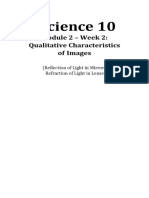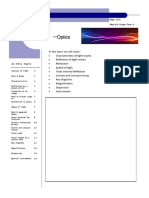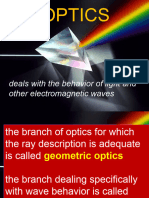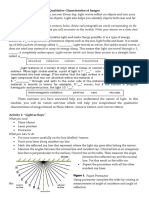Eve Ross - 10.2 - Reflection of Light
Eve Ross - 10.2 - Reflection of Light
Uploaded by
Eve RossCopyright:
Available Formats
Eve Ross - 10.2 - Reflection of Light
Eve Ross - 10.2 - Reflection of Light
Uploaded by
Eve RossCopyright
Available Formats
Share this document
Did you find this document useful?
Is this content inappropriate?
Copyright:
Available Formats
Eve Ross - 10.2 - Reflection of Light
Eve Ross - 10.2 - Reflection of Light
Uploaded by
Eve RossCopyright:
Available Formats
SNC2D
10.2 - Reflection of Light
Recall: Light can be absorbed reflected or
transmitted
Therefore all materials are transparent,
translucent, or opaque
Light properties and reflection Regardless if the source of light, all light b
eaves the same
-a reflection is the change in the direction of a
light ray when it bounces off a surface.
Smooth shiny surfaces like calm water,
mirrors, glass and even polished metal allow
you to see an image
An image is a reproduction of an object
produced by an optical device like a mirror
Light will always travel in a straight line if its
moving through the same medium
The medium is the substance through which
light travels
Ray Tracing and Fermat’s Principle Ray diagrams are used to demonstrate the
behavior of light by representing the direction
light is traveling
Basic terminology of a ray diagram:
Incident ray: rat of light that travels from a
light source toward a surface
Angle of incidence: the angle between the
incident ray and the normal
Normal: a line that is perpendicular to a
surface where a ray of light meets the surface
Reflected ray: a ray that begins at the point
where the incident ray and the normal meet
Angle of reflection: the angle between the
reflected ray and the normal in a ray diagram
Fermat's principle states that light will always
follow the path between two points that takes
the least amount of time
1. The incident ray, reflection ray, and
the normal always lie on the same
plane
2. When light reflects off a surface, the
angle of incidence equals the angle of
reflection
Light and Matter Ray diagrams can help explain why the
brightness of a light changes with distance
The more rays that reach your eyes, the
brighter the object appears
Diffuse Reflection
Many surfaces appear smooth but actually
aren't
Because of the uneven surface, light rays are
scattered in many directions but they still
obey the laws of reflection
Most objects are made of rough surfaces. If
this didn't happen indoor lighting wouldn't be
effective
Optical Images An image is the representation of an object
formed by the interaction of light rays
4 characteristics: size, attitude, location, type\
Real images: mirrors can produce images
that can be projected on a screen a real
image is always inverted and appears in front
of the mirror
Virtual image: mirrors can also produce
images that cannot be projected on a sc reen.
A virtual image is always upright and appears
behind the mirror
Images in Plane Mirrors
Plane mirrors are mirrors with flat reflective
surfaces
Whe objects are viewed through mirrors a
virtual image is produced on the surface of
the mirror. The image seems to be coming
from behind the mirror
Our brains assume that the light has travelled
in a straight line and thus sees the object
behind the surface of a mirror
On ray diagrams the virtual image is drawn
behind the reflective surface with dashes rays
emitting from it
Drawing Images in Plane Mirrors: Step 1:
Step 2:
Step 3:
Step 4:
Summary of Images in Plane Mirrors (Using SALT)
Plane mirrors continued….
Applications of Plane Mirrors: Bathroom mirrors
Rearview mirrors
periscope
You might also like
- Amc Senior 7 PDFDocument2 pagesAmc Senior 7 PDFRUSDIN, S.Si100% (2)
- Project Report On RectifierDocument10 pagesProject Report On RectifierHArsh92% (12)
- Science 10 Quarter 2 Module 5Document8 pagesScience 10 Quarter 2 Module 5Jess Anthony Efondo100% (4)
- Intro To LightDocument49 pagesIntro To Lightlolak81979No ratings yet
- Science10 Q2 Mod3 QualitativeCharacteristicsOfImagesDocument12 pagesScience10 Q2 Mod3 QualitativeCharacteristicsOfImagesKOBE BRYANT TIDOYNo ratings yet
- Grade 9 Notes On Unit 4 LIGHTDocument5 pagesGrade 9 Notes On Unit 4 LIGHTDeepa Jeewaheer100% (2)
- Print - Light WavesDocument22 pagesPrint - Light WavesantonellidejanNo ratings yet
- Science ReviewerDocument7 pagesScience ReviewerniezlNo ratings yet
- Qualitative Characteristics of Images: Absorbed Reflection Scatters TransmittedDocument6 pagesQualitative Characteristics of Images: Absorbed Reflection Scatters TransmittedMira Verano100% (1)
- Physics Revision ModuleDocument23 pagesPhysics Revision Modulexohepe1676No ratings yet
- Science10_Q2_Mod3_QualitativeCharacteristicsOfImagesDocument7 pagesScience10_Q2_Mod3_QualitativeCharacteristicsOfImagesJean Sachin JacaNo ratings yet
- G10 Q2 Week 6Document3 pagesG10 Q2 Week 6Rogelio SonioNo ratings yet
- Notes LightDocument17 pagesNotes Lightdeore.nitin1699No ratings yet
- Science 10 2nd Quarter Lesson SummaryDocument3 pagesScience 10 2nd Quarter Lesson SummaryAbigail CastroNo ratings yet
- Grade 10 Quarter 2 Module 3 - Qualitative CharacteristicsDocument14 pagesGrade 10 Quarter 2 Module 3 - Qualitative CharacteristicsAlljhon Dave Joshua Magno100% (1)
- Physics 122Document107 pagesPhysics 122stephenalfa7No ratings yet
- LightDocument76 pagesLightchamelisubashNo ratings yet
- Reflection and Refraction of LightDocument63 pagesReflection and Refraction of Lightzarish ziaNo ratings yet
- GRADE 10 QUARTER 2 SCIENCE HeheDocument18 pagesGRADE 10 QUARTER 2 SCIENCE Hehevq9rp5jx7xNo ratings yet
- Unit 7: Light Rays & Waves Notes Part 7.01 & 7.02: Luminous ObjectsDocument3 pagesUnit 7: Light Rays & Waves Notes Part 7.01 & 7.02: Luminous ObjectsRAMAN KUMARNo ratings yet
- Learning Plan in Science 10: Unit Topic: Content Standard: Learning CompetenciesDocument13 pagesLearning Plan in Science 10: Unit Topic: Content Standard: Learning Competenciesakoaysijoy100% (1)
- Light EnergyDocument23 pagesLight EnergySarveshrau Sarvesh100% (1)
- 05 LIGHT Physics Form 4Document11 pages05 LIGHT Physics Form 4Nikki NinjaNo ratings yet
- Light - Free Exam AcademyDocument20 pagesLight - Free Exam AcademysinojiayogNo ratings yet
- Physics: ReflectionDocument11 pagesPhysics: ReflectionMa-anJaneDiamos100% (1)
- 350992444-Optics NMAT ReviewerDocument11 pages350992444-Optics NMAT ReviewerKorra SamiNo ratings yet
- Science Reflection-Of-Light MirrorsDocument3 pagesScience Reflection-Of-Light MirrorsAchilles ToringNo ratings yet
- OpticsDocument25 pagesOpticsSam LoveNo ratings yet
- G8 Phys Light Reflection Refraction Refractive Index and DispersionDocument17 pagesG8 Phys Light Reflection Refraction Refractive Index and DispersionAMV LIFENo ratings yet
- Chapter 13Document185 pagesChapter 13farhanasikder123No ratings yet
- Reflection Mirrors 2022 2023Document92 pagesReflection Mirrors 2022 2023Jeon ManobanNo ratings yet
- Mirrors Lenses LectureDocument40 pagesMirrors Lenses LecturemiravellemilletNo ratings yet
- Reflection and Refraction NotesDocument5 pagesReflection and Refraction NotesJo StandleyNo ratings yet
- Reflection of LightDocument34 pagesReflection of LightTrisha Esplana Second100% (1)
- Summary of Chapter WavesDocument8 pagesSummary of Chapter WavesAzeem iftikharNo ratings yet
- 9 LIGHT AND REFLECTIONDocument15 pages9 LIGHT AND REFLECTION34suryanshagarwalNo ratings yet
- Mirror'sDocument21 pagesMirror'sjanaicaackermanNo ratings yet
- Chapter 14 Reflection and Refraction of LightDocument37 pagesChapter 14 Reflection and Refraction of Lightdylonnnaocha3No ratings yet
- Mirrors and LensesDocument41 pagesMirrors and LensesMyriel Jean LuigNo ratings yet
- Light 1Document54 pagesLight 1Jovy GagabuanNo ratings yet
- Physical Science Module 3Document5 pagesPhysical Science Module 3Karen PaslonNo ratings yet
- Q2C3L2 Introduction and Plane MirrorsDocument25 pagesQ2C3L2 Introduction and Plane Mirrorsashleeyishin30No ratings yet
- Light Reflection & RefractionDocument29 pagesLight Reflection & Refractionmacff217No ratings yet
- Light and OpticsDocument76 pagesLight and OpticsTni Jolie100% (2)
- (12136) mIRRORSDocument23 pages(12136) mIRRORSppatsNo ratings yet
- Ray OpticsDocument77 pagesRay OpticsDiksha PublicationNo ratings yet
- OPTICS-Gr.10-Departmental-Lessons - Mirros - Lenses and Electricity & Magnetism (Student-Copy)Document19 pagesOPTICS-Gr.10-Departmental-Lessons - Mirros - Lenses and Electricity & Magnetism (Student-Copy)Sir Bryan CamuNo ratings yet
- Qualitative Characteristics of ImagesDocument23 pagesQualitative Characteristics of Imagesmantilejoshua05No ratings yet
- P 13 Light 0625Document165 pagesP 13 Light 0625ravi.komaragiri76No ratings yet
- Light Stem 12Document35 pagesLight Stem 12Pauline GonzagaNo ratings yet
- Optics - Reflection, Refraction and LensesDocument46 pagesOptics - Reflection, Refraction and LensesBrianna Malcolm100% (1)
- Light: Secondary 3 PhysicsDocument22 pagesLight: Secondary 3 PhysicsKoh Seok HweeNo ratings yet
- Science 10 - Week 16Document6 pagesScience 10 - Week 16Mira VeranoNo ratings yet
- The Nature and Properties of Light PDFDocument19 pagesThe Nature and Properties of Light PDFB VIDATTE VILLANIEVANo ratings yet
- Light and OpticsDocument58 pagesLight and OpticsPARVEEN KAUR A/P MONHEN SINGH MoeNo ratings yet
- Types of ReflectionDocument3 pagesTypes of ReflectionArjix HandyManNo ratings yet
- Physics 2 Week4Document19 pagesPhysics 2 Week4basurahangyujNo ratings yet
- PS Quarter 2 Week 3Document6 pagesPS Quarter 2 Week 3edgardo viadorNo ratings yet
- Chapter 9 -X PPTDocument8 pagesChapter 9 -X PPTdazzlingmelody910No ratings yet
- Cylindrical Perspective: Cylindrical Perspective: Exploring Visual Perception in Computer VisionFrom EverandCylindrical Perspective: Cylindrical Perspective: Exploring Visual Perception in Computer VisionNo ratings yet
- Eve Ross - Optics Virtual LabDocument10 pagesEve Ross - Optics Virtual LabEve RossNo ratings yet
- Eve Ross - SNC2Dfinalexamreview Jan23Document7 pagesEve Ross - SNC2Dfinalexamreview Jan23Eve RossNo ratings yet
- Eve Ross - 10.3a - Note - Images in Concave MirrorsDocument8 pagesEve Ross - 10.3a - Note - Images in Concave MirrorsEve RossNo ratings yet
- Eve Civics MasternoteDocument13 pagesEve Civics MasternoteEve RossNo ratings yet
- Thevenin Theorem: Practice Exercise 4Document5 pagesThevenin Theorem: Practice Exercise 4Martin Recentes100% (1)
- 201-250physics Oou Post UtmeDocument9 pages201-250physics Oou Post UtmeKalu ComforterNo ratings yet
- TopSolid TG Wood Basics v6 16 UsDocument109 pagesTopSolid TG Wood Basics v6 16 Usheron1000No ratings yet
- LG Bus Duct System: Leader in Electrics & AutomationDocument51 pagesLG Bus Duct System: Leader in Electrics & AutomationRajneesh KatochNo ratings yet
- A Review of Geopressure Evaluation From Well Logs PDFDocument9 pagesA Review of Geopressure Evaluation From Well Logs PDFmurbieta100% (1)
- 1d Collisions Lab ReportDocument8 pages1d Collisions Lab ReportSimon WairimuNo ratings yet
- RG Classes: 143, Ram Gali No. 3, Raja Park, JaipurDocument21 pagesRG Classes: 143, Ram Gali No. 3, Raja Park, JaipurLokesh SahNo ratings yet
- Manuel Gómez, Ph.D. Curriculum VitaeDocument36 pagesManuel Gómez, Ph.D. Curriculum VitaeManuel GomezNo ratings yet
- AN4190 Application Note: Antenna Selection GuidelinesDocument29 pagesAN4190 Application Note: Antenna Selection Guidelinespasquale_dottoratoNo ratings yet
- (Secl-r0-Hv-CA-tba-0001 - Rev - 1) (Hvac & Plumbing Calculation For Control Building)Document101 pages(Secl-r0-Hv-CA-tba-0001 - Rev - 1) (Hvac & Plumbing Calculation For Control Building)jeromejoeNo ratings yet
- Math 280 Final Guide (2019) - SmithDocument9 pagesMath 280 Final Guide (2019) - SmithzaneNo ratings yet
- Trubolt Xtrem Seismic - Mechanical Anchors - SarbDocument8 pagesTrubolt Xtrem Seismic - Mechanical Anchors - SarbTerry cheukNo ratings yet
- Calcium 5-Nitriminotetrazolate - A New Green Replacement For Lead Azide in Priming ChargesDocument15 pagesCalcium 5-Nitriminotetrazolate - A New Green Replacement For Lead Azide in Priming Chargesmaru1318No ratings yet
- Compact Micro Strip Patch Antenna For Wlan Application: A Project ReportDocument67 pagesCompact Micro Strip Patch Antenna For Wlan Application: A Project ReportBavithraNo ratings yet
- Our Mission: The Coax LeaderDocument3 pagesOur Mission: The Coax LeaderArindam BanerjeeNo ratings yet
- Building Codes and Construction in The United States 1949Document4 pagesBuilding Codes and Construction in The United States 1949Libre Joel IanNo ratings yet
- 03004-03006-03007 S1-Complex Analysis and Numerical Methods-QPDocument3 pages03004-03006-03007 S1-Complex Analysis and Numerical Methods-QPARAV PRAJAPATINo ratings yet
- Overview On S-Box Design PrinciplesDocument11 pagesOverview On S-Box Design PrinciplescomputerengineeringNo ratings yet
- Algorithms - ProblemsDocument98 pagesAlgorithms - ProblemsAmir RamiNo ratings yet
- Mastering The Lateral ShuffleDocument5 pagesMastering The Lateral Shuffleapi-316929727No ratings yet
- Science GeographyDocument133 pagesScience Geographysampcant212No ratings yet
- Wheatstone BridgeDocument18 pagesWheatstone Bridgethiagarajan sNo ratings yet
- Application of Adomian's Approximations To The Navier-Stokes Equations in Cylindrical CoordinatesDocument5 pagesApplication of Adomian's Approximations To The Navier-Stokes Equations in Cylindrical CoordinateswahabmathsNo ratings yet
- UTS Kls 12 Semester 1Document4 pagesUTS Kls 12 Semester 1Tiara Nove RiaNo ratings yet
- The Sequential Optimal Attitude Recursion FilterDocument20 pagesThe Sequential Optimal Attitude Recursion FiltergantebrasNo ratings yet
- Project Proposal DelhiDocument27 pagesProject Proposal DelhiTarun RathoreNo ratings yet
- IMSO 2018 - Science Experiment Part 1Document9 pagesIMSO 2018 - Science Experiment Part 1Supornchai ChaireokNo ratings yet
- Solstice EquinoxDocument5 pagesSolstice Equinoxmegasasso9633No ratings yet





























































































